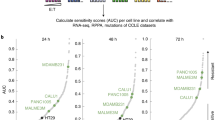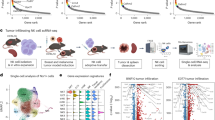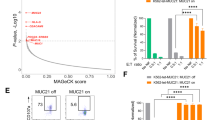Abstract
Natural killer (NK) cells are an important component of the cancer immune surveillance system. They are regulated by germline-encoded receptors that activate and inhibit their effector function, such as secretion of cytokines and direct lysis of tumor cells and virus-infected cells. Without the need to be primed by prior exposure to tumor antigen, NK cells can detect ligands expressed on tumor cells and selectively kill these cells. NK cells are under strict control by inhibitory receptors that bind to HLA class I on target cells and block early activation signals, thus preventing lysis of target cells. The sensitivity to lysis by NK cells is therefore determined to a large extent by the expression of HLA class I molecules on tumor cells. In addition to receptor–ligand interactions that occur at NK–target cell synapses, many other factors determine the sensitivity of tumor cells to lysis by NK. Intrinsic properties of tumor cells, such as their metabolism and signaling networks establish a threshold above which they will succumb to the death pathways triggered by NK cell attack. Here we provide a protocol for a genome-wide CRISPR screen in tumor cells to identify factors that regulate their sensitivity to primary human NK cells. Tumor cells first transduced for expression of Cas9 are then transduced with a guide RNA (gRNA) library and co-cultured with NK cells. Deep sequencing of the library generated from the genome of tumor cells that survived the selection by NK cells and analysis of the distribution of guide RNAs is performed to identify genes that promote either sensitivity or resistance to NK-mediated killing. The contribution of individual genes to tumor sensitivity can be validated by knockouts using individual gRNAs. The techniques and workflow described here could be applied to primary tumors from cancer patients and reveal tumor-specific points of vulnerability that could be exploited for cancer immunotherapy, such as checkpoint blockade or expression of chimeric antigen receptors specifically designed to activate NK cell cytotoxicity.
Access this chapter
Tax calculation will be finalised at checkout
Purchases are for personal use only
Similar content being viewed by others
References
Russell JH, Ley TJ (2002) Lymphocyte-mediated cytotoxicity. Annu Rev Immunol 20:323–370. https://doi.org/10.1146/annurev.immunol.20.100201.131730
Moretta L, Moretta A (2004) Killer immunoglobulin-like receptors. Curr Opin Immunol 16:626–633. https://doi.org/10.1016/j.coi.2004.07.010
Lee N et al (1998) HLA-E is a major ligand for the natural killer inhibitory receptor CD94/NKG2A. Proc Natl Acad Sci U S A 95:5199–5204
Zhuang X, Long EO (2019) Inhibition-resistant CARs for NK cell cancer immunotherapy. Trends Immunol 40:1078–1081. https://doi.org/10.1016/j.it.2019.10.004
Souza-Fonseca-Guimaraes F, Cursons J, Huntington ND (2019) The emergence of natural killer cells as a major target in cancer immunotherapy. Trends Immunol 40:142–158. https://doi.org/10.1016/j.it.2018.12.003
Zhuang X, Veltri DP, Long EO (2019) Genome-wide CRISPR screen reveals cancer cell resistance to NK cells induced by NK-derived IFN-gamma. Front Immunol 10:2879. https://doi.org/10.3389/fimmu.2019.02879
Myers JA, Miller JS (2021) Exploring the NK cell platform for cancer immunotherapy. Nat Rev Clin Oncol 18:85–100. https://doi.org/10.1038/s41571-020-0426-7
Zhuang X, Long EO (2019) CD28 homolog is a strong activator of natural killer cells for lysis of B7H7(+) tumor cells. Cancer Immunol Res 7:939–951. https://doi.org/10.1158/2326-6066.CIR-18-0733
Bryceson YT, March ME, Ljunggren HG, Long EO (2006) Synergy among receptors on resting NK cells for the activation of natural cytotoxicity and cytokine secretion. Blood 107:159–166. https://doi.org/10.1182/blood-2005-04-1351
Morvan MG, Lanier LL (2016) NK cells and cancer: you can teach innate cells new tricks. Nat Rev Cancer 16:7–19. https://doi.org/10.1038/nrc.2015.5
Fernald K, Kurokawa M (2013) Evading apoptosis in cancer. Trends Cell Biol 23:620–633. https://doi.org/10.1016/j.tcb.2013.07.006
Freeman AJ et al (2019) Natural Killer Cells Suppress T Cell-Associated Tumor Immune Evasion. Cell Rep 28:2784–2794 e2785. https://doi.org/10.1016/j.celrep.2019.08.017
Pech MF et al (2019) Systematic identification of cancer cell vulnerabilities to natural killer cell-mediated immune surveillance. Elife 8:e47362. https://doi.org/10.7554/eLife.47362
Shalem O et al (2014) Genome-scale CRISPR-Cas9 knockout screening in human cells. Science 343:84–87. https://doi.org/10.1126/science.1247005
Wang T, Wei JJ, Sabatini DM, Lander ES (2014) Genetic screens in human cells using the CRISPR-Cas9 system. Science 343:80–84. https://doi.org/10.1126/science.1246981
Koike-Yusa H, Li Y, Tan EP, Velasco-Herrera Mdel C, Yusa K (2014) Genome-wide recessive genetic screening in mammalian cells with a lentiviral CRISPR-guide RNA library. Nat Biotechnol 32:267–273. https://doi.org/10.1038/nbt.2800
Kearney CJ et al (2018) Tumor immune evasion arises through loss of TNF sensitivity. Sci Immunol 3:eaar3451. https://doi.org/10.1126/sciimmunol.aar3451
Sanjana NE, Shalem O, Zhang F (2014) Improved vectors and genome-wide libraries for CRISPR screening. Nat Methods 11:783–784. https://doi.org/10.1038/nmeth.3047
Joung J et al (2017) Genome-scale CRISPR-Cas9 knockout and transcriptional activation screening. Nat Protoc 12:828–863. https://doi.org/10.1038/nprot.2017.016
Li W et al (2015) Quality control, modeling, and visualization of CRISPR screens with MAGeCK-VISPR. Genome Biol 16:281. https://doi.org/10.1186/s13059-015-0843-6
Henriksson J et al (2019) Genome-wide CRISPR screens in T helper cells reveal pervasive crosstalk between activation and differentiation. Cell 176:882–896 e818. https://doi.org/10.1016/j.cell.2018.11.044
Acknowledgements
This work was supported by the Intramural Research Program of the National Institutes of Health, National Institute of Allergy and Infectious Diseases.
Author information
Authors and Affiliations
Corresponding author
Editor information
Editors and Affiliations
Rights and permissions
Copyright information
© 2022 The Author(s), under exclusive license to Springer Science+Business Media, LLC, part of Springer Nature
About this protocol
Cite this protocol
Zhuang, X., Long, E.O. (2022). CRISPR Screen to Identify Factors that Render Tumor Cells Sensitive or Resistant to Killing by NK Cells. In: Shimasaki, N. (eds) Natural Killer (NK) Cells. Methods in Molecular Biology, vol 2463. Humana, New York, NY. https://doi.org/10.1007/978-1-0716-2160-8_19
Download citation
DOI: https://doi.org/10.1007/978-1-0716-2160-8_19
Published:
Publisher Name: Humana, New York, NY
Print ISBN: 978-1-0716-2159-2
Online ISBN: 978-1-0716-2160-8
eBook Packages: Springer Protocols




